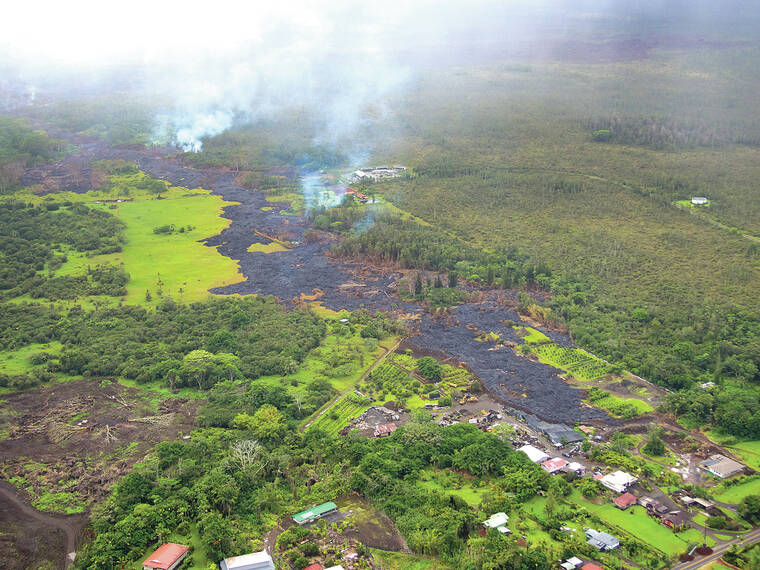Over the past few years, eruptions of Kilauea volcano on the Island of Hawaii have happened in remote regions and lava flows have not directly threatened communities. However, the approaching anniversary of a lava flow crisis a decade ago reminds us that eruptions on Kilauea have the potential to cause damage and island-wide disruption.
The 2018 lower East Rift Zone eruption of Kilauea is still fresh in many of our minds, but even before then, Kilauea lava flows entering communities was not uncommon. During the 35-year-long eruption of Pu‘u‘o‘o, on the East Rift Zone of Kilauea, lava flows caused destruction in Royal Gardens, Kalapana, and in Pahoa. Before Pu‘u‘o‘o, there were also eruptions in Kapoho Village in 1960 and on Kilauea’s lower East Rift Zone in 1955.
Ten years ago, inflation at Pu‘u‘o‘o in May and June lead to a new eruptive episode on the northeast flank of the cone. It was informally named episode 61e, but more commonly referred to as the June 27 flow in reference to the start date of that episode in 2014.
In the first few days, four fissures produced channelized flows before the eruption focused at the lowest elevation vent, where a perched pond began to form. The pond elevation continued to rise until it was about 30 meters (100 ft) higher than the vent. On July 10, pressure from the perched pond triggered the eruptive vent to shift to the next highest fissure and abandon the perched pond.
The change in eruptive vent produced a fast-moving channelized flow that traveled up to several hundred meters (yards) per day. The flow continued to the northeast until it extended across the eastern edge of the Pu‘u‘o‘o flow field by the beginning of August.
On August 18, the lava entered into a deep ground crack that directed the flow further to the northeast. After about a week the lava overflowed from the crack, before repeating this pattern at three additional and parallel ground cracks. The flow traveled roughly 5 km (3 mi) underground in these cracks to within about 1.2 km (0.7 mi) of Ka‘ohe Homesteads subdivision where the lava exited the final crack in early September.
The flow front advanced slow and steadily during the first few weeks of September, passing Ka‘ohe Homesteads to the northwest. Then from late-September to early-October, the lava flow’s rate of advance began to fluctuate as it stalled and advanced. Towards the end of October, a breakout surged through a narrow drainage and crossed Cemetery Road in Pahoa. The flow continued through the Pahoa Japanese Cemetery, through private property, and destroyed one structure, stalling only 155 m (510 ft) from Pahoa Village Road.
A large breakout on November 14 occurred roughly 6.5 km (4 mi) upslope of the flow front, and rapidly advanced along the northwest margin of the previous flow, ultimately headed towards Pahoa Marketplace and Highway 130. The flow front again stalled on December 30 after advancing to within 530 m (0.3 mi) of the marketplace. That was the furthest the lava flow advanced, but numerous breakouts just upslope continued to threaten Pahoa until early 2015.
Episode 61e, or the June 27 flow, then retreated upslope and stayed within about 8 km (5 mi) of Pu‘u‘o‘o. This episode continued until early June 2016, when inflation at Pu‘u‘o‘o culminated in two new eruptive vents on the northeast (episode 61f) and southeast (episode 61g) flanks of the cone on May 24.
The episode 61f flow was short-lived, lasting less than two weeks. However, the 61g flow remained active until the Pu‘u‘o‘o crater floor collapsed on April 30, 2018, followed by the intrusion of magma into the lower East Rift Zone and subsequent eruption.
Since then, eruptions from Kilauea have fortunately been confined within Kaluapele (Kilauea caldera) or other remote areas of Hawaii Volcanoes National Park. Currently, there are no signs of magma moving into the East Rift Zone but that will inevitably happen again someday. The Pahoa lava flow crisis and other destructive East Rift Zone eruptions are reminders that communities on or near the rift zone are vulnerable. Residents and visitors should stay informed and remember that it’s never too early consider how an eruption could impact you and your family.
Volcano
activity updates
Kilauea is not erupting. Its USGS Volcano Alert level is ADVISORY.
Kilauea erupted briefly on June 3 southwest of Kaluapele (Kilauea caldera) within the closed area of Hawaii Volcanoes National Park. Sulfur dioxide emission rates remain elevated; an emission rate of 350 tonnes per day was measured on June 10, for the combined areas of Kilauea summit and the recent eruption. Seismicity in the summit region, including the upper East Rift Zone, has been slightly elevated with about 550 events over the past week. Inflationary ground deformation has continued in the summit region. Additional pulses of seismicity and deformation could result in new eruptive episodes within the area or elsewhere on the Southwest Rift Zone.
Mauna Loa is not erupting. Its USGS Volcano Alert Level is at NORMAL.
Webcams show no signs of activity on Mauna Loa. Summit seismicity has remained at low levels over the past month. Ground deformation indicates continuing slow inflation as magma replenishes the reservoir system following the 2022 eruption. SO2 emission rates are at background levels.
One earthquake was reported felt in the Hawaiian Islands during the past week: a M3.4 earthquake 14 km (8 mi) S of Volcano at 1 km (1 mi) depth on June 6 at 12:29 p.m. HST.
HVO continues to closely monitor Kilauea and Mauna Loa.
Please visit HVO’s website for past Volcano Watch articles, Kilauea and Mauna Loa updates, volcano photos, maps, recent earthquake information, and more. Email questions to askHVO@usgs.gov.
Volcano Watch is a weekly article and activity update written by U.S. Geological Survey Hawaiian Volcano Observatory scientists and affiliates.
























/cdn.vox-cdn.com/uploads/chorus_asset/file/25782636/247422_ChatGPT_anniversary_CVirginia.jpg)
/cdn.vox-cdn.com/uploads/chorus_asset/file/25789444/1258459915.jpg)

/cdn.vox-cdn.com/uploads/chorus_asset/file/25546252/STK169_Mark_Zuckerburg_CVIRGINIA_D.jpg)

